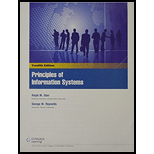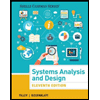
PRINCIPLES OF INFO.SYS.(LL)>CUSTOM PKG<
12th Edition
ISBN: 9781337074674
Author: STAIR
Publisher: CENGAGE C
expand_more
expand_more
format_list_bulleted
Expert Solution & Answer
Chapter 12, Problem 13RQ
Explanation of Solution
Pareto principle:
- The Pareto principle (also known as the 80–20 rule) is a rule of thumb used in business that helps people focus on the vital 20 percent that generate 80 percent of the results.
- This principle means that implementing 20 percent of the system requirements can achieve 80 percent of the desired system benefits.
- An 80–20 option will have a low cost and quick completion schedule relative to other potential options.
- However, this option may not be an ideal solution and may not even be acceptable to the users, stakeholders, and the steering team who may be expecting more...
Expert Solution & Answer
Want to see the full answer?
Check out a sample textbook solution
Students have asked these similar questions
Manhattan distance
Aiwhat cost from Oradea to Goal which Eforie us A* Algorithm G(n)+H(n) last what ıs the cost
What is the SELECT statement? give one reference with your answer
What is a URL and what is it used for? give one reference with your answer
What is e-mail, and what are its advantages? Give one reference with your answer
Chapter 12 Solutions
PRINCIPLES OF INFO.SYS.(LL)>CUSTOM PKG<
Ch. 12.5 - Prob. 1DQCh. 12.5 - Prob. 2DQCh. 12.5 - Prob. 1CTQCh. 12.5 - Prob. 2CTQCh. 12.8 - Prob. 1DQCh. 12.8 - Prob. 2DQCh. 12.8 - Prob. 1CTQCh. 12.8 - Prob. 2CTQCh. 12 - Prob. 1SATCh. 12 - Prob. 2SAT
Ch. 12 - Prob. 3SATCh. 12 - The ______ is a key member and the leader of the...Ch. 12 - Prob. 5SATCh. 12 - Prob. 6SATCh. 12 - Prob. 7SATCh. 12 - Prob. 8SATCh. 12 - Prob. 9SATCh. 12 - Prob. 10SATCh. 12 - Feasibility analysis is typically done during...Ch. 12 - Data modeling is most often accomplished through...Ch. 12 - Prob. 13SATCh. 12 - Prob. 14SATCh. 12 - Any potential change in system requirements that...Ch. 12 - Prob. 1RQCh. 12 - Prob. 2RQCh. 12 - Prob. 3RQCh. 12 - Prob. 4RQCh. 12 - Prob. 5RQCh. 12 - Prob. 6RQCh. 12 - Prob. 7RQCh. 12 - Prob. 8RQCh. 12 - Prob. 9RQCh. 12 - Prob. 10RQCh. 12 - Prob. 11RQCh. 12 - Prob. 12RQCh. 12 - Prob. 13RQCh. 12 - Prob. 14RQCh. 12 - Prob. 15RQCh. 12 - Prob. 16RQCh. 12 - Prob. 1DQCh. 12 - Prob. 3DQCh. 12 - Prob. 5DQCh. 12 - Prob. 6DQCh. 12 - Prob. 10DQCh. 12 - Prob. 11DQCh. 12 - Prob. 1DQ1Ch. 12 - Prob. 2DQ1Ch. 12 - Prob. 1CTQ1Ch. 12 - Prob. 2CTQ1Ch. 12 - Prob. 1DQ2Ch. 12 - Prob. 2DQ2Ch. 12 - Prob. 1CTQ2Ch. 12 - Prob. 2CTQ2Ch. 12 - Prob. 1DQ3Ch. 12 - Prob. 2DQ3Ch. 12 - Prob. 1CTQ3Ch. 12 - Prob. 2CTQ3
Knowledge Booster
Similar questions
- What is the difference between the World Wide Web (WWW) and the Internet? Give two references from a journal along with your answer.arrow_forwardDiscuss with appropriate examples, the types of relationship in a database. Give two references from an article.arrow_forwardWhat is a cloud and why do we use it? Give one reference with your answer.arrow_forward
- What are triggers and how do you invoke a trigger on demand? give one reference with your anwer.arrow_forwardWhy is database normalization important? Give one reference with your answer.arrow_forwardDescribe the role of databases and database management systems in the context ofenterprise systems. Give two references with your answer.arrow_forward
- Is it advisable to run a test on a live database? Give reasons. Also give one reference from an article.arrow_forwardFor context and I am looking for someone with experience in either computer graphics with companies, or at least has an expertise or experiences in engine development.I am developing a game engine. The niche that I want to focus in open-world development to specialize in.I have seen, heard, and had discussions about various approaches to scene graphs and ways they get handled to be sent to the renderer.If I wanted to focus on open-world, what are different tips and approaches you can tell me of how complex scenes. Like open-world get rendered? What I mean when asking this question, what is the design layout typically of a few approaches that is used for rendering not just basic scenes but complex scenes? Especially since I want to focus on building a game engine that hopes to focuse in open-world.I am using the entity component system framework EnTT, and would like to know if you can also provide tips and how that framework can be incorporated into the design layouts of how you've…arrow_forwardPlease original work Describe the steps of the process of data discovery Why each one is important to data analysis and data warehousing frameworks. Please cite in text references and add weblinksarrow_forward
- The following is code for a disc golf program written in C++: player.h: #ifndef PLAYER_H #define PLAYER_H #include <string> #include <iostream> class Player { private: std::string courses[20]; // Array of course names int scores[20]; // Array of scores int gameCount; // Number of games played public: Player(); // Constructor void CheckGame(const std::string& courseName, int gameScore); void ReportPlayer(int playerId) const; }; #endif // PLAYER_H player.cpp: #include "player.h" #include <iomanip> Player::Player() : gameCount(0) {} void Player::CheckGame(const std::string& courseName, int gameScore) { for (int i = 0; i < gameCount; ++i) { if (courses[i] == courseName) { // If course has been played, check for minimum score if (gameScore < scores[i]) { scores[i] = gameScore; // Update to new minimum score } return; // Exit after…arrow_forwardWhat is the cyclomatic complexity of the diagram below, and how did you find it?arrow_forwardWrite the following code segment in MARIE’s assembly language:if X <= Y thenY = Y - 1;else if X != Zthen Y = Y + 1;else Z = Z - 1arrow_forward
arrow_back_ios
SEE MORE QUESTIONS
arrow_forward_ios
Recommended textbooks for you
 Principles of Information Systems (MindTap Course...Computer ScienceISBN:9781285867168Author:Ralph Stair, George ReynoldsPublisher:Cengage Learning
Principles of Information Systems (MindTap Course...Computer ScienceISBN:9781285867168Author:Ralph Stair, George ReynoldsPublisher:Cengage Learning Principles of Information Systems (MindTap Course...Computer ScienceISBN:9781305971776Author:Ralph Stair, George ReynoldsPublisher:Cengage Learning
Principles of Information Systems (MindTap Course...Computer ScienceISBN:9781305971776Author:Ralph Stair, George ReynoldsPublisher:Cengage Learning Fundamentals of Information SystemsComputer ScienceISBN:9781337097536Author:Ralph Stair, George ReynoldsPublisher:Cengage Learning
Fundamentals of Information SystemsComputer ScienceISBN:9781337097536Author:Ralph Stair, George ReynoldsPublisher:Cengage Learning Information Technology Project ManagementComputer ScienceISBN:9781337101356Author:Kathy SchwalbePublisher:Cengage Learning
Information Technology Project ManagementComputer ScienceISBN:9781337101356Author:Kathy SchwalbePublisher:Cengage Learning Systems Analysis and Design (Shelly Cashman Serie...Computer ScienceISBN:9781305494602Author:Scott Tilley, Harry J. RosenblattPublisher:Cengage Learning
Systems Analysis and Design (Shelly Cashman Serie...Computer ScienceISBN:9781305494602Author:Scott Tilley, Harry J. RosenblattPublisher:Cengage Learning Management Of Information SecurityComputer ScienceISBN:9781337405713Author:WHITMAN, Michael.Publisher:Cengage Learning,
Management Of Information SecurityComputer ScienceISBN:9781337405713Author:WHITMAN, Michael.Publisher:Cengage Learning,

Principles of Information Systems (MindTap Course...
Computer Science
ISBN:9781285867168
Author:Ralph Stair, George Reynolds
Publisher:Cengage Learning

Principles of Information Systems (MindTap Course...
Computer Science
ISBN:9781305971776
Author:Ralph Stair, George Reynolds
Publisher:Cengage Learning

Fundamentals of Information Systems
Computer Science
ISBN:9781337097536
Author:Ralph Stair, George Reynolds
Publisher:Cengage Learning

Information Technology Project Management
Computer Science
ISBN:9781337101356
Author:Kathy Schwalbe
Publisher:Cengage Learning

Systems Analysis and Design (Shelly Cashman Serie...
Computer Science
ISBN:9781305494602
Author:Scott Tilley, Harry J. Rosenblatt
Publisher:Cengage Learning

Management Of Information Security
Computer Science
ISBN:9781337405713
Author:WHITMAN, Michael.
Publisher:Cengage Learning,